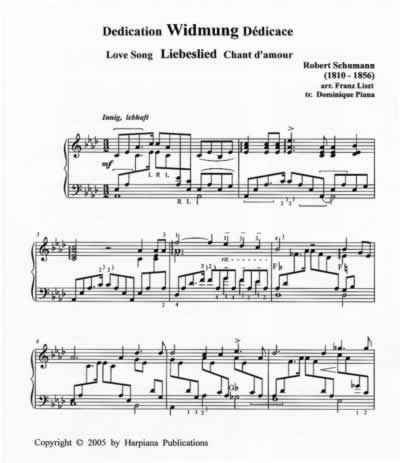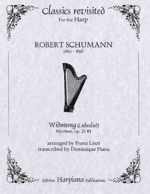| Editions
Harpiana Publications: Classics Revisited
Arranged by Franz Liszt, transcribed for harp by Dominique Piana Buy this music now Score: £8.75 + p&p |
The story of Widmung, called Liebeslied in the piano transcription by Liszt, actually begins with the German poet, philologist and translator Friedrich Rückert (1788-1866).
From the heroic to the amorous, nothing romantic was foreign to Rückert. On one hand, his political opposition to Napoleon inspired early epic and martial poetry (Deutsche Gedichte, 1814), on the other, as a scholar in Oriental languages, he introduced the German readership to Arabic, Persian, Indian and Chinese poetry. Schubert set his famous songs Du bist die Ruh and Lachen und Weinen on his verses imitating the ghazal, after the 14th c. Persian poet Hafiz. Even his personal work is suffused with oriental mysticism, as exemplified by some of the Kindertotenlieder later set by Mahler. Still, he became most renowned for his love lyrics (Liebesfrühling, 1823), which flowed in abundance from his pen during the courtship of his future wife Luise Wiethaus Fischer, whom he married in 1821.
Then, in 1840, twelve years since his last dabble in art song, Robert Schumann experienced his "year of song", an outpouring of masterworks only equaled by his predecessor Schubert. Schumann had already spent many years refining his piano writing in a great variety of character pieces, unspoken attempts at pure music despite their programmatic titles. But now, as a young man finally anticipating happiness after a protracted legal battle to gain consent for his marriage to Clara Wieck, he needed a more direct means of expression.
Already in February he had completed some of the songs he would call Myrthen op. 25 -- Myrten in modern German and translated as Myrtle in English. Contrary to the Liederkreise op. 24 and op. 39, which are song cycles unified around a common poet, Myrthen was loosely assembled around a different purpose... On the eve of their September 12 wedding, Robert brought these songs to Clara as a Polterabend (shower) gift. Their importance to Schumann can be fathomed from a comment he made in a letter to Zuccalmaglio later, in December, that "the Myrthen certainly allow a deeper insight into my inner musical workings".
More than anything else, Widmung matters as a celebration of Love, human love triumphant. It opens the op. 25 set with the most powerful expression of shared love. The music not only echoes the words but also amplifies and transcends their earthly resonance. As the voice sings and the piano accompanies, without any artifice, nothing can stand in the way of the song's innig, lebhaft (intimate, lively) passion.
In 1848, Franz Liszt found himself on a similar wavelength and created a sumptuous concert version of Widmung for solo piano (S 566/R 253). Relinquishing the wandering life of the virtuoso to devote himself to composition, he had decided to lay anchor in the small but historically significant town of Weimar. He was in the midst of experiencing a fervent renewal of faith and the solace of unconditional love offered by Princess Carolyne Sayn-Wittgenstein.
He also wrote a simpler, unadorned version that follows Schumann's Lied closely. The present harp transcription is based on an autograph of the latter found in the Library of Congress, in Washington D.C.
After comparing Liszt's transcription with Schumann's original, a few rhythmic adjustments have been made and the notes have been divided between the hands in a manner more conducive to harp fingering and technical facility. Nothing has been simplified; the phrasing has rather been made explicit, so that the focus of the performer can go directly to the expression of the life energy awaiting release.
Françoise Bourret has typeset the music in Finale. It was recorded in 1996 on the solo harp CD Beyond Dreams, also available from Harpiana.
Dominique Piana

| Title: | Widmung (Liebeslied) Myrthen, op. 25 #1 |
| Composer: |
Robert Schumann (1810-1856) |
| Arranger: | Arranged by Franz Liszt, transcribed for harp by Dominique Piana |
| Instrumentation: | Harp |
| Level: | Intermediate to Advanced |
| Format: | Harp Part stapled |
| Size: | 11" x 8.5" (US Letter) |
| ISMN: | Not issued |
| Our Ref: | DP007 |
| Publisher: | Editions Harpiana Publications |
| Series: | Classics Revisited |
| Edition/Year: | 2005 |
| Origin: | USA |
